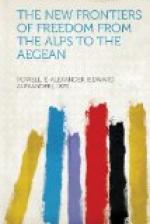Leaving Lissa to starboard, we steamed through the Canale di Sabbioncello, with exquisite panoramas unrolling on either hand, and dropped anchor off the quay of Curzola, where the governor of the islands, Admiral Piazza, awaited us with his staff. In spite of the bleakness of the surrounding mountains, Curzola is one of the most exquisitely beautiful little towns that I have ever seen. The next time you are in the Adriatic you should not fail to go there. Time and the hand of man—for the people are a color-loving race—have given many tints, soft and bright, to its roofs, towers, and ramparts. It is a town of dim, narrow, winding streets, of steep flights of worn stone steps, of moss-covered archways, and of some of the most splendid specimens of the domestic architecture of the Middle Ages that exist outside of the Street of the Crusaders in Rhodes. The sole modern touches are the costumes of the islanders, and they are sufficiently picturesque not to spoil the picture. How the place has escaped the motion-picture people I fail to understand. (As a matter of fact, it hasn’t, for I took with me an operator and a camera—the first the islanders had ever seen.) Besides the Cathedral of San Marco, with its splendid doors, its exquisitely carved choir-stalls black with age and use, its choir balustrade and pulpit of translucent alabaster, and its dim old altar-piece by Tintoretto, the town boasts the Loggia or council chambers, the palace of the Venetian governors, the noble mansion of the Arnieri, and, brooding over all, a towering campanile, five centuries old. The Lion of St. Mark, which appears on several of the public buildings, holds beneath its paw a closed instead of an open book—symbolizing, so I was told, the islanders’ dissatisfaction with certain laws of the Venetians.
But the phase of my visit which I enjoyed the most was when Admiral Piazza took us across the bay, on a Detroit-built submarine-chaser, to a Franciscan monastery dating from the fifteenth century. We were met by the abbot at the water-stairs, and, after being shown the beautiful Venetian Gothic cloisters, with alabaster columns whose carving was almost lacelike in its delicate tracery, we were led along a wooded path beside the sea, over a carpet of pine-needles, to a cloistered rose-garden, in which stood, amid a bower of blossoms, a blue and white statue of the Virgin. The fragrance of the flowers in the little enclosure was like the incense in a church, above our heads the great pines formed a canopy of green, and the music was furnished by the birds and the murmuring sea. Here we seemed a world away from the waiting armies and the great gray battleships, from the quarrels of Latin and Slav. It was the first real peace that I had known after five years of war, and I should have liked to remain there longer. But Montenegro, Albania, Macedonia, all the unhappy, war-torn lands of the Near East lay before me, and I turned reluctantly away. But my thoughts keep harking back to the little town beside the turquoise bay, to the restfulness of its old, old buildings, to the perfume of its flowers, and the whispering voice of its turquoise sea. So some day, when the world is really at peace and there are no more wars to write about, I think that I shall go back to where




